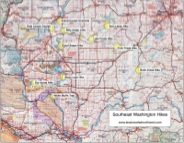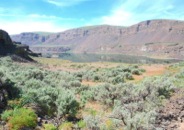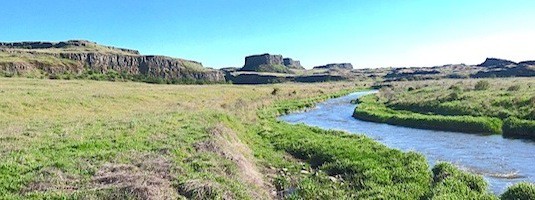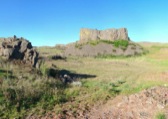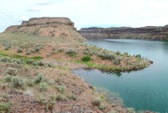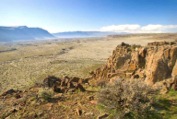Less Traveled Northwest
Day Hikes for the Adventurous
Southeast Washington Hikes
Southeast Washington is an anomaly in the Inland Northwest, having little public land compared with other regions. The reason is the deep loess soils and long growing season that support dryland wheat farming and irrigated agriculture, despite a desert climate with less than 15 inches of rain each year. In many counties here, more than 80% of the land area is cultivated. However, due to the unique geology of the region, the remaining natural areas under public ownership offer some of the best, less-traveled desert hikes in the Northwest.
This unique geology stems from Ice Age megafloods that scoured the basalt bedrock of Southeast Washington 18,000 to 15,000 years ago. These enormous floods, caused by repeated damming and cataclysmic release of rivers in Montana by the continental ice sheet, roared through the Inland Northwest on their way to the sea. The volume and velocity of water was so great it swept away soils and bedrock in the existing valleys, leaving deep "coulees" flanked by vertical walls of basalt and "scablands" washed clean of overlying soils. Today, these channeled scablands — some with rimrock lakes or pothole marshes, some with small streams, and others completely dry — form a unique desert terrain for day hiking.
Download (PDF, 941 KB): Location Map of Southeast Washington Hikes
Download (PDF, 662 KB): Photos of Southeast Washington Area
Though these flood channels cover nearly 2,000 square miles in Southeast Washington, most are privately-owned and used for livestock grazing. Fortunately, public land agencies have acquired a few ranches within the scablands, through both purchases and land exchanges. Notably, the BLM has acquired several tracts of 10 to 25 square miles and Washington State has also accumulated significant holdings. Several of these scabland tracts are large enough to provide a feeling of wilderness solitude, even though wheat fields are just a few miles away.
It’s these larger and more remote tracts within the coulee flood channels that are the focus of our day hikes:
Eastern Scabland Hikes
The most remote and extensive channeled scablands are in the eastern portion of the region. All four of our chosen hikes here are more than an hour's drive from Spokane, all are on lands managed by the BLM and they represent a wide spectrum of scabland terrain. The coulees at Rock Creek and Crab Creek both have perennial streams flowing through them. The lower Lake Creek coulee, though dry since the 1990s due to groundwater pumping, still offers spectacular scenery. The Twin Lakes hike features deep rimrock lakes, marshes and stands of ponderosa pine.
> Rock Creek Coulee Hike
> Lake Creek Coulee Hike
> Twin Lakes Hike
> Crab Creek Coulee Hike
Grand Coulee Area Hikes
By far the largest and most diverse coulee in Southeast Washington is Grand Coulee — more than 60 miles long, up to 4 miles wide and more than 1,000' deep in places. Our hike here follows an historical stagecoach road up a side canyon to a panoramic overlook on the rim. Both the Billy Clapp Lake and East Lenore Coulee hikes explore nearby flood channels, the first with a 5-mile long reservoir and the second a hidden, dry coulee with dramatic basalt cliffs. The Gloyd Seeps hike features pothole marshes and lakes, Spring wildflowers and abundant birdlife.
> Grand Coulee Overlook Hike
> Billy Clapp Lake Hike
> East Lenore Coulee Hike
> Gloyd Seeps Hike
Southern Scabland Hikes
Least remote and extensive are the southern scablands. We’ve selected three contrasting hikes, each more than an hour's drive from major cities and each with wilderness solitude. The hike to Black Lake is a cross-country trek along benches above several deep rimrock lakes. The Dry Island hike is an overland desert ramble, traversing the lower Crab Creek coulee to a scenic rim. Finally, we include the White Bluffs Trail, a dramatic hike on sandstone bluffs and dunes above the last free-flowing reach of the upper Columbia River.
> Black Lake Hike
> Dry Island Hike
> White Bluffs Trail
NOTE: Since the Northern Blue Mountains extend only about 30 miles into Southeast Washington, for the sake of simplicity these hikes are included in our Northeast Oregon geographic region (see our Northern Blue Mountain Hikes), rather than on a separate Southeast Washington web page here.
Clickable map of Southeast Washington hikes:
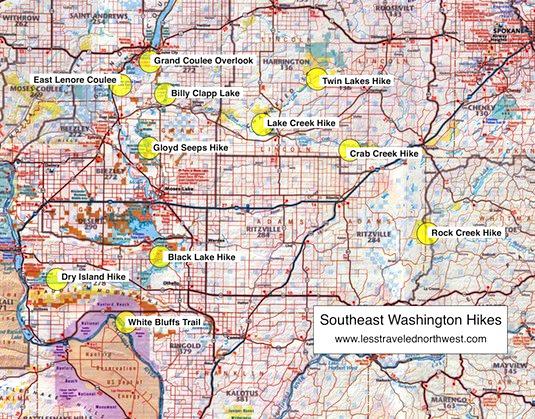
Page last updated: 12/8/14

